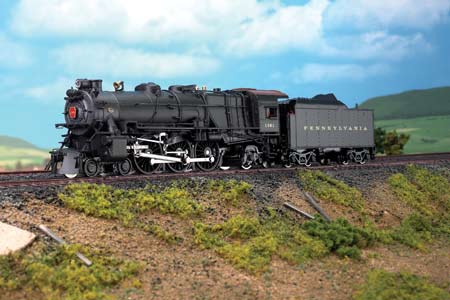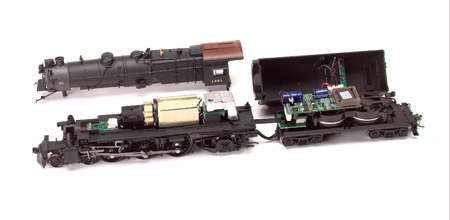The prototype. For the first half of the 20th century the PRR was a massive transportation machine with a standardized locomotive fleet concentrated in five standard designs. The K4s Pacific was the railroad’s primary heavy passenger locomotive for nearly 40 years.
In the K4s, PRR combined the best features of its other successful locomotives with an expanded firebox to obtain maximum capacity to handle fast passenger trains. Overall, 425 K4s locomotives were built between 1914 and 1928.
These heavy Pacifics had superheaters for even greater boiler efficiency (indicated by the “s” in the class designation). Given their role in passenger service, the K4s Pacifics quickly became the most recognized locomotives on Pennsy’s roster.
The K4s locomotives handled the crush of wartime traffic during World Wars I and II, and many of these veterans remained in service for four decades. When the trains became too heavy for one engine, PRR simply double-headed them.
This model closely matches the prototype drawings of a K4s in the Model Railroader Cyclopedia: Vol. 1, Steam Locomotives (Kalmbach Publishing Co.) except for the driver spacing. Like other steam models, the overall driver wheelbase is stretched about a scale 10″ to provide clearance for oversize model flanges. While the K4s model will negotiate curves as sharp as 18″ radius, it looks much better on wider curves.
The BLI K4s is offered in three late-model versions. Our sample is a post-1947 rebuild with the generator and access platform mounted on the smokebox front and a solid pilot fitted with a drop coupler. Other K4s versions include a similar post-1947 rebuild with a slatted pilot, and an engine with the original boiler front and slatted pilot.
New design. This K4s model is mostly cast metal with a variety of separately applied metal details. These castings include the boiler and tender shell which provide much of the weight that contributes to the locomotive’s pulling power.
The mechanism has an interesting new two-piece frame casting that includes the firebox ash pan, the motor mount, and gearbox. A second casting incorporates the running boards, bottom segment of the boiler, and the firebox. The metal cylinders and pilot are attached with screws.
A large can motor, fitted with a turned-brass flywheel, is concealed within the firebox to power the middle pair of drivers through a worm and worm gear. Motion is transferred to the other drivers through the cast-metal side rods. Electrical pickup is through all six drivers but only four tender wheels.
Our sample is smoothly painted in PRR’s Dark Green Locomotive Color. Freight Car Color (a boxcar red) appears on the tender deck, and it’s properly mixed with black for the cab roof. The locomotive’s smoke-box and firebox are graphite. The gold lettering is sharp and legible, even on the Juniata Shop builder’s plates. The drivers, trucks, and frame are painted black, and the rods and wheel treads are darkened metal.
Our K4s has a dummy coupler on the pilot, but it also accepts a working McHenry scale magnetic knuckle coupler. A Kadee no. 5 coupler, mounted at the proper height, comes on the tender.
A reed switch located just behind the tender’s coal bunker allows use of a magnetic wand (included) for manual volume control and to reset the sound and electronic controls. Two downward-facing speakers are mounted on the tender floor.
The factory-installed QSI Quantum sound system delivers a wide selection of automatic and user- controlled sounds. Its chuffing is synchronized at four exhausts per driver revolution, and the whistle is simply great. A slave setting mutes the whistle and bell on the second engine for double-heading.
Performance. On DC the sound started up at 4 volts, but it took 8.75 volts to get the locomotive moving smoothly at only 2.8 scale mph. Its speed range matched the prototype,
and the model developed a drawbar pull equivalent to 56 free-rolling freight cars (or 18 passenger cars) on straight and level track.
After I swapped the rear drivers to the optional set with traction tires, the drawbar pull jumped to an amazing 233 freight cars (about 77 passenger cars). The current also climbed from .22 to .52 amps.
This engine’s high starting voltage is due to the QSI Quantum control and sound system operating in the DC mode. This starting voltage can be adjusted downward, but the minimum remains about 5 volts.
Pennsy fans will like this K4s’ realism and performance for service in the late steam and early diesel transition era.
Price: DC models, $299.99 each;
models with automatic
dual-mode DCC decoder and
sounds system, $450
Manufacturer
Broadway Limited Imports
601 Shenandoah Village Drive
Suite 9 E/F
Waynesboro, VA 22980
540-949-8300
www.broadway-limited.com
Description
Plastic and metal ready-to-run
steam locomotive with sound
Road Names (All Penzylvania)
Nos. 1361, 5418, or unlettered,
modernized with solid pilot
Nos. 646, 1453, and unlettered,
original version
Nos. 5451, 7279, and
unlettered, modernized with
slatted pilot
Automatic dual-mode
(DC/DCC) control and sound
system
Blackened drivers and wheels
Constant directional headlight
and rear marker
Die-cast construction
Drawbar pull: 4 ounces with
plain drivers or 16.6 ounces
with optional traction tires
Engine and tender weight: 28
ounces (engine alone weighs
21 ounces)
Five-pole can motor with
flywheel
Kadee magnetic knuckle
coupler on the tender; pilot
holds a McHenry scale
magnetic coupler or a dummy
coupler
Minimum radius: 18″ (larger radius is recommended)
RP-25 contour wheels, in gauge
Snap-lock drawbar















